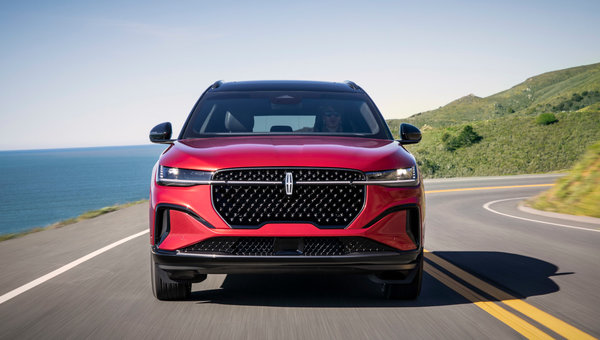Understanding the 2026 Aviator's Twin-Turbo V6: Power Meets Efficiency
October 28 2025,

The refreshed Lincoln Aviator brings meaningful updates for 2026, yet its powertrain remains a strategic constant. The twin-turbocharged 3.0-litre V6 engine delivers 400 horsepower and 415 lb-ft of torque, providing the performance Ontario families need for three-row SUV duties while maintaining efficiency that makes sense for daily driving.
Understanding how this engine works and why Lincoln chose twin-turbo technology over alternatives helps buyers appreciate the engineering decisions behind the Aviator's performance characteristics. This technology serves practical purposes beyond just producing impressive power figures.
How Twin-Turbo Technology Works
The Aviator's 3.0-litre V6 employs two turbochargers rather than the single turbo found in some competitors. Each turbocharger compresses incoming air before it enters the engine cylinders, forcing more oxygen into the combustion chamber than a naturally aspirated engine can draw on its own. More oxygen allows more fuel to burn, generating more power from the same displacement.
Using two smaller turbochargers instead of one large unit reduces turbo lag—the delay between pressing the accelerator and feeling the power boost. One turbocharger handles lower engine speeds while the second engages at higher RPMs, creating a broader, more linear power band. This configuration delivers responsive acceleration from stop signs and traffic lights, which matters more in daily driving than peak horsepower numbers.
The engine pairs with a 10-speed automatic transmission that keeps the engine operating in its most efficient range across varying speeds. On Ontario highways, the transmission seamlessly shifts between gears to balance power delivery with fuel economy, making long trips to cottage country or across the province more economical.
Performance for Family Hauling
The 400 horsepower rating positions the Aviator competitively in the three-row luxury segment, but torque tells the more relevant story for family vehicle buyers. The 415 lb-ft of torque arrives at lower engine speeds, providing the pulling power needed for merging onto Highway 400, passing slower vehicles on two-lane roads, or climbing hills with a full load of passengers and cargo.
Three-row SUVs carry significant weight—the Aviator tips scales around 2,300 kilograms depending on configuration. The twin-turbo V6 moves this mass without strain, maintaining confident performance even with all seats occupied and the cargo area filled with camping equipment or sports gear.
The Aviator also handles light towing duties, with properly equipped models rated for up to 2,950 kilograms. This capacity accommodates boat trailers, utility trailers, or small campers that families across Simcoe County might tow to nearby lakes or provincial parks.
Efficiency in Ontario Driving Conditions
Twin-turbo engines historically carried a reputation for thirst, but modern engineering has changed this equation. The Aviator's fuel economy ratings reflect this progress, achieving reasonable efficiency for a vehicle of its size and capability.
In city driving around Alliston, where stop-and-go traffic and frequent idling test efficiency, the engine employs stop-start technology that automatically shuts down at red lights and restarts when you release the brake. This feature reduces fuel consumption during typical urban driving without requiring driver input.
On highway routes like Highway 89 connecting Alliston to surrounding areas, the combination of direct fuel injection and variable valve timing optimizes combustion efficiency at cruising speeds. The 10-speed transmission keeps the engine operating at lower RPMs during steady highway driving, reducing fuel consumption on longer trips.
Winter conditions across Ontario don't significantly hamper the Aviator's performance. The twin-turbo configuration generates heat quickly, bringing the engine and cabin to operating temperature faster than naturally aspirated engines. Available intelligent four-wheel drive distributes power to wheels with the most traction, maintaining confident handling on snow-covered roads.
What Twin-Turbo Means for Maintenance

Twin-turbo engines include additional components compared to naturally aspirated engines, which raises maintenance considerations. The turbochargers themselves are robust components designed for the vehicle's lifespan, but they operate at extremely high temperatures and pressures.
Regular oil changes become particularly important in turbocharged engines. The turbochargers rely on engine oil for both lubrication and cooling, making oil quality and change intervals more critical than in non-turbo engines. Following Lincoln's recommended maintenance schedule protects the turbochargers and ensures long-term reliability.
The Aviator includes adaptive suspension as standard equipment, which works in coordination with the powertrain to optimize ride quality and handling. This system monitors road conditions and adjusts damping rates continuously, allowing the engine's power to transfer to the road efficiently without sacrificing the smooth ride Ontario families expect from a luxury SUV.
Comparing Twin-Turbo to Alternative Powertrains
Some three-row competitors employ naturally aspirated V6 engines or hybrid systems. Each approach brings trade-offs that buyers should understand.
Naturally aspirated engines deliver linear, predictable power but typically require larger displacement to match twin-turbo output. A 3.5-litre naturally aspirated V6 might produce similar horsepower to the Aviator's 3.0-litre twin-turbo, but with less torque and lower efficiency. The smaller displacement twin-turbo engine reduces weight while maintaining performance.
Hybrid three-row SUVs offer improved fuel economy but add system complexity, weight, and cost. For families covering moderate annual distances primarily on highways rather than congested city streets, the efficiency gains don't always justify the hybrid premium. The Aviator's twin-turbo provides a practical middle ground between pure gasoline and hybrid technology.
Key Specifications
- Engine Type: Twin-turbocharged 3.0-litre V6
- Horsepower: 400 hp
- Torque: 415 lb-ft
- Transmission: 10-speed automatic
- Drivetrain: Rear-wheel drive (standard), Intelligent four-wheel drive (available)
- Towing Capacity: Up to 2,950 kg (properly equipped)
The Aviator Advantage for Ontario Families
The Aviator's twin-turbo V6 addresses practical needs facing Ontario families. It provides confident passing power for two-lane rural roads while maintaining reasonable fuel economy for highway commutes. It handles cottage-country towing duties without struggle. It warms up quickly during winter cold snaps.
Beyond raw capability, the engine operates quietly, contributing to the serene cabin environment Lincoln emphasizes across its lineup. The twin-turbo configuration delivers power smoothly without the mechanical thrashing some high-output engines produce, maintaining the refined character Ontario luxury buyers expect.
For families in Alliston managing school runs, weekend activities, and the occasional road trip to Toronto or beyond, this powertrain strikes a practical balance. It doesn't chase maximum horsepower figures or fuel economy records. Instead, it delivers reliable, capable performance that serves real family needs day after day.
Experience the Aviator at Trillium Lincoln
The refreshed Aviator's twin-turbo V6 demonstrates how modern engine technology serves practical family needs. Visit Trillium Lincoln in Alliston to experience how this powertrain delivers in real-world driving conditions across Ontario. Our team can arrange test drives on varied routes that showcase the engine's responsive acceleration, smooth power delivery, and confident highway cruising character.




